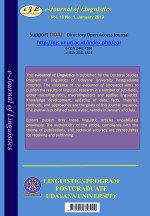Meaning of Phrasal Verb ‘Pick up’ Subtype Do/Happen: A Natural Semantic Metalanguage Approach
Abstract
The difficulties in knowing and understanding the meaning of a language often appear in units of language with an idiomatic meaning, such as phrasal verb. A single unit of phrasal verb usually produce a meaning which is totally different with the meaning of its constituent. Phrasal verb ‘pick up’ is a unique phrasal verb since it is able to give various meanings unlike the other phrasal verbs. Furthermore, the implementation of Natural Semantic Metalanguage (NSM) as a theory in this study lead to a great significance in order to avoid misunderstanding the meaning of phrasal verb ‘pick up’ by defining the meaning through semantic structures. This study is intended to find and describe the meanings of phrasal verb ‘pick up’. The result of this study showed that phrasal verb pick up is a kind of transitive phrasal verb which often followed by object. The different objects in phrasal verb ‘pick up’ lead to non-composition polysemi between DO / HAPPEN. This combination of two polysemies comes in eight meanings.
Downloads
References
Fletcher, B. 2005. Register and Phrasal Verbs. MED Magazine. The Monthly Webzine of McMillan English Dictionaries, 33, 45-54.
Goddard, C. 1996. “Building a Universal Semantic Metalanguage” the Semantic Theory of Anna Weirzbicka’ dalam C. Goddard (ed) 1996. Cross Linguistic Syntax from a
Semantic Point of View (NSM Approach). Canberra: Australian National University.
Quirk, Pandolf and Sidney Greenbaum. 1975. A University Grammar of English. London: Longman Group Limited
Strauss dan Corbin J. 2003. Dasar-Dasar Penelitian Kualitatif : Tata langkah dan Teknik- Teknik Teorisasi Data. Pustaka Pelajar, Yogyakarta: Abimanyu, et al.
Sudaryanto. 2015. Metode dan Aneka Teknik Analisis Bahasa. Yogyakarta: Sanata Dharma University Press
Sudipa, I N. 2004. “Verba Bahasa Bali: Sebuah Kajian Metabahasa Semantik Alami (MSA). Disertasi”. Denpasar: Program Pascasarjana, Unversitas Udayana.
Sudipa, I N. 2010. Struktur Semantik: Verba Keadaan Bahasa Bali. Denpasar: Udayana University Press
Sumitri, ni wayan et al. Form and meaning of ti'i ka discourse in mbasa wini ritual of rongga ethnic in flores.e-journal of linguistics, [s.l.], jan. 2015. Issn 2442-7586.
Sutjiati Beratha, Ni Luh. 1997. Basic Concept of a Universal Semantic Metalanguage. Linguistika, tahun IV Edisi keenam, 110-115
Utami, I Made Verayanti; Apriliani, Kadek; Sugiarti, Dian Pramita. 10.24843 The Analysis of Indonesian Transitive and Intransitive Verbs Found in the Translation of Possum Magic - An Australian Classic by BIPA Students of La Denpasar. e-Journal of Linguistics, [S.l.], v. 12, n. 2, p. 79-87, july 2018. ISSN 2442-7586.
Wierzbicka Anna. 1996. Semantics: Prime and Universal. Oxford: Oxford University

This work is licensed under a Creative Commons Attribution 4.0 International License.

This work is licensed under a Creative Commons Attribution 4.0 International License











